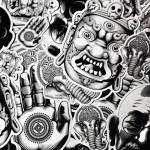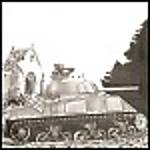




I'm slowly getting where I want to be, finally.

















Pics as of this afternoon, detail painting still going on.
I'm slowly getting where I want to be, finally.










Okay, it's slow here so I've got a bit of time. Pedro, here it is, as succinctly as I can:
Starting with a glossy enamel or laquer base paint that's as close to the desired base color as you can get, apply an overall wash of the color you would normally use to apply a pin and/or dirt wash. I use a large-ish, soft bristle brush for this step, as the only gotta-do here is to achieve complete coverage. The important thing here is that the wash must be a type of paint that is thinned and easily removed with a non-aggressive solvent, like water or rubbing alcohol (Tamiya acrylics work well for me). Next, after letting the wash dry to the touch, begin the removal process. For this I use a Q-tip moistened with rubbing alcohol, cheap vodka or water. Alcohol leaves a very slight haze which dries totally flat. Vodka and water usually leave no residue. The choice of solvents used here can, by design, influence your finish. I have found that the alcohol haze can be removed with a Q-tip and water. Also, the amount of wash left will influence your final color just as a filter will. And, a particular area can be "polished" to show a cleaner area, such as the top of a turret or high-traffic area.
I have used this technique over a flat color coat, but the color coat will absorb a portion of the wash color, which can be good or bad, and can be used to your benefit.
Back to the wash-removal process, the amount of wash left on is minimal, and can be done in such a way as to create highlights, almost like color modulation. For detailed and tight areas, I'll use a brush of the appropriate size, moistened with solvent, and move the wash to where I need it or where I can get to it with a Q-tip to remove it completely.
Experimentation is the ticket here, and I'm sure there are variations of this I haven't tried or thought of yet. I mainly started doing it because I don't have an airbrush and was looking for a way to blend color with dirt and grime, and leave a dusty, flat finish. I was also having problems with "water marks" when doing pin washes. This technique does all that for me, and combined with wet and dry pastels, can leave a very realistic appearance. I've used this process on desert tan, OD, German dark yellow and British dk. green, and two and three tone camo. A quick coat of clear flat, pigments, and I'm done.
Hope this is clear enough to be of help......
























...There is no real reason for a double action gun for modeling. 95% of the time you'll be using the air action full on....


Quoted Text...There is no real reason for a double action gun for modeling. 95% of the time you'll be using the air action full on....
I disagree. I rarely use my Badger Sotar at full blast. Through careful manipulation of the trigger, you can achieve a hairline pattern without a pressure regulator. With my Iwata HP-C Plus, I find it sprays too much paint if you open it up.



Quoted TextQuoted Text...There is no real reason for a double action gun for modeling. 95% of the time you'll be using the air action full on....
I disagree. I rarely use my Badger Sotar at full blast. Through careful manipulation of the trigger, you can achieve a hairline pattern without a pressure regulator. With my Iwata HP-C Plus, I find it sprays too much paint if you open it up.
Matt, all you're really doing is varying the AP to draw a fine line, assuming that you paint mix is correct. Like I said, I've been using the same single action gun for more then 40 years, and have it down to a science. For a fine line, adjusted paint mix, setting the regulator knob to 12-15 psi takes less then 30 sec. From that point on I don't have to worry or play with the button trying to hold it steady for the entire painting session. And for free hand camo applications can be a hour or two easily. I can take a break, and when I go back to it, I can easily and quickly duplicate my procedure.
Like I said, I've been doing it this way for more then 40 years. I like the simplicity of a single action gun, and it's ease of clean up. I've tried a few double action brushes, and just don't care for them. Their primary use is for artists working in watercolors and inks.
Joel







Quoted TextQuoted TextQuoted Text...There is no real reason for a double action gun for modeling. 95% of the time you'll be using the air action full on....
I disagree. I rarely use my Badger Sotar at full blast. Through careful manipulation of the trigger, you can achieve a hairline pattern without a pressure regulator. With my Iwata HP-C Plus, I find it sprays too much paint if you open it up.
Matt, all you're really doing is varying the AP to draw a fine line, assuming that you paint mix is correct. Like I said, I've been using the same single action gun for more then 40 years, and have it down to a science. For a fine line, adjusted paint mix, setting the regulator knob to 12-15 psi takes less then 30 sec. From that point on I don't have to worry or play with the button trying to hold it steady for the entire painting session. And for free hand camo applications can be a hour or two easily. I can take a break, and when I go back to it, I can easily and quickly duplicate my procedure.
Like I said, I've been doing it this way for more then 40 years. I like the simplicity of a single action gun, and it's ease of clean up. I've tried a few double action brushes, and just don't care for them. Their primary use is for artists working in watercolors and inks.
Joel
I find a double action ab very user friendly. I can take breaks too. My Sotar has a dial that sets the needle to draw back a certain distance. Therefore, I don't need to adjust it every time. I'm sorry you haven't joined the revolution, but that's not my concern.



Quoted TextQuoted TextQuoted TextQuoted Text...There is no real reason for a double action gun for modeling. 95% of the time you'll be using the air action full on....
I disagree. I rarely use my Badger Sotar at full blast. Through careful manipulation of the trigger, you can achieve a hairline pattern without a pressure regulator. With my Iwata HP-C Plus, I find it sprays too much paint if you open it up.
Matt, all you're really doing is varying the AP to draw a fine line, assuming that you paint mix is correct. Like I said, I've been using the same single action gun for more then 40 years, and have it down to a science. For a fine line, adjusted paint mix, setting the regulator knob to 12-15 psi takes less then 30 sec. From that point on I don't have to worry or play with the button trying to hold it steady for the entire painting session. And for free hand camo applications can be a hour or two easily. I can take a break, and when I go back to it, I can easily and quickly duplicate my procedure.
Like I said, I've been doing it this way for more then 40 years. I like the simplicity of a single action gun, and it's ease of clean up. I've tried a few double action brushes, and just don't care for them. Their primary use is for artists working in watercolors and inks.
Joel
I find a double action ab very user friendly. I can take breaks too. My Sotar has a dial that sets the needle to draw back a certain distance. Therefore, I don't need to adjust it every time. I'm sorry you haven't joined the revolution, but that's not my concern.
Oh please Matt... the models Joel has posted online are every bit as good as what you've posted. Revolution...? pftt...






 |